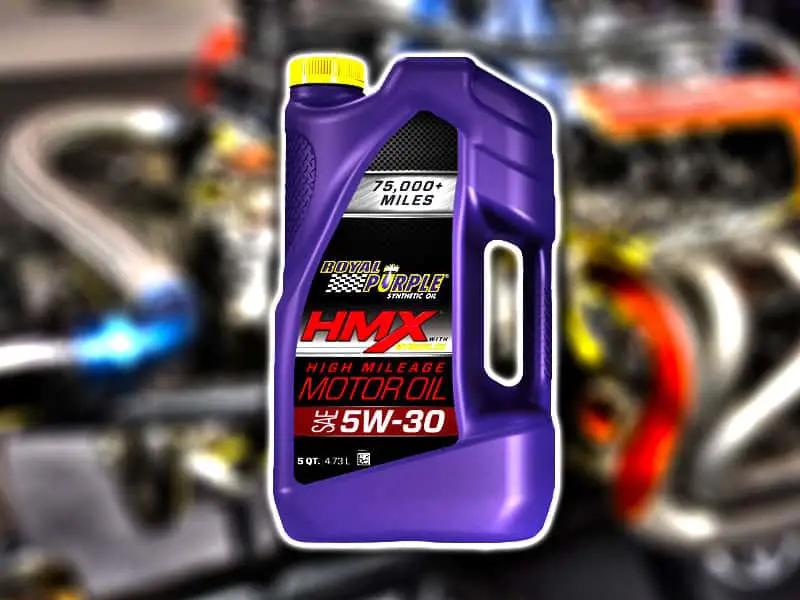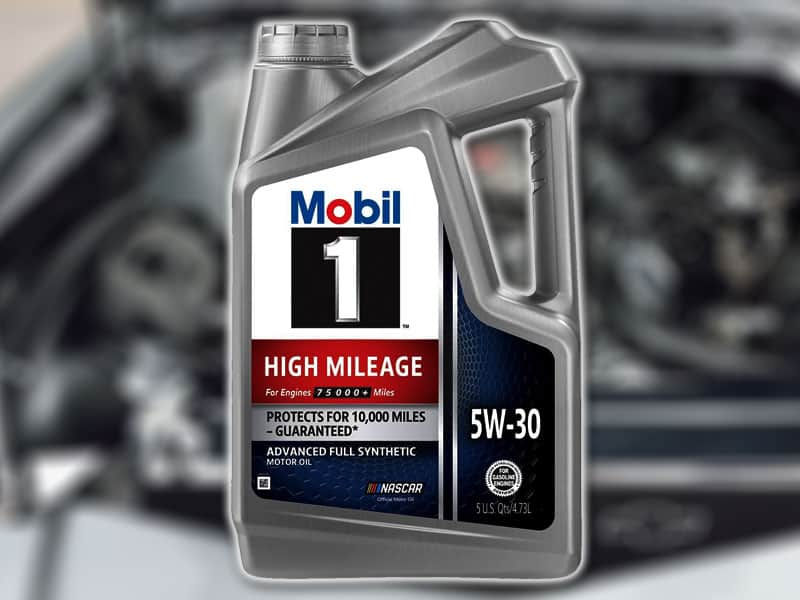Both these oils are fully synthetic and are used in gasoline engines. Royal Purple HMX focuses mainly on engine cleaning while the Mobil 1 High mileage pays attention to the engine performance at higher temperatures.
HMX specifically focuses on removing the sludge, with the help of a high number of detergent additives. The good quality and greater number of anti-wear agents also assist it to lower the wearing and tearing of the engine. It has a high number of base additives (higher TBN value) to increase the oil changing duration.


High Mileage oil, on the other hand, is catalytic converter-friendly which protects the oil from early burn-off problems. It has a decent number of calcium and magnesium-based additives to remove the sludge from the engine. The anti-foaming agent is also present in high quantity to lower the problem of foam build-up. It is also very cheap and provides better fuel economy.

Table of Contents
Quick Table
| Specifications | Royal Purple HMX (5W-30) | Mobil 1 High Mileage (5W-30) |
| Oil Type | Fully Synthetic | Fully Synthetic |
| Engine Type | Gasoline | Gasoline |
| Available viscosity grades | 5W-20, 5W-30, 10W-30 | 0W-20, 5W-20, 5W-30, 10W-30, 10W-40 |
| ILSAC | GF-5 | GF-6 |
| API | SN | SL, SM, SN, SN PLUS, CF |
| Cost (5 Quart.) | 49.44$ | 27.47$ |
| Oil change frequency (miles) | 12,000 | 10,000 |
| Additives | Anti-wear, Detergents, Dispersants | Detergents, Dispersants, Anti-foam agents, Anti-wear |
| ACEA | Unavailable | Unavailable |
Comparison of Oil Burn-off Comparison
Oil burning-off depends on the presence of light molecules. These lighter molecules will burn easily and will have a greater chance of evaporating quickly. The greater number of lighter-weight molecules will cause the oil to reach its flashpoint (ignition point) at a lower temperature.
The flashpoint temperature of HMX is lower than its peer. It indicates that it has a higher number of lighter molecules and will burn off more quickly. Conversely, High mileage oil has a high flashpoint temperature, resulting in relatively better oil burn-off protection.
| Oils in Comparison (5W-30 Grade oils) | Flash Point Temperatures (Degrees Celsius) |
| Royal Purple HMX | 230 |
| Mobil 1 High Mileage | 245 |
Comparison of Engine Wear-off Protection
To reduce the wearing and tearing of the engine, anti-wear additives are added to the motor oil. These additives form a thin film around the moving (metal) parts of the engine reducing their friction. Greater these anti-wearing additives, lower will be wearing of the engine and vice versa.
HMX mainly contains zinc and phosphorus compounds as anti-wearing agents. Molybdenum is also present in higher quantities in the oil. High mileage oil has a lower number of these anti-wearing additives. Likewise, it also contains zinc and phosphorus in the majority amount while boron-based compounds are also present in frequent numbers. But overall, HMX comes out on top in protecting the engine from wear and tear.
| Oils in Comparison (5W-30 Grade oils) | Zinc Concentration (ppm) | Phosphorus Concentration (ppm) | Boron Concentration (ppm) | Molybdenum Concentration (ppm) | Titanium Concentration (ppm) |
| Royal Purple HMX | 951 | 866 | 20 | 139 | 0 |
| Mobil 1 High Mileage | 822 | 690 | 95 | 79 | <1 |
Viscosity Comparison
Kinematic viscosity is known as the resistance to flow of a motor oil. Higher kinematic viscosity results in better performance of the oil at high temperatures. The viscosity index of the oil is the variation in the viscosity of the oil with the change in temperature. The lowest temperature at which fluid continues its flowing property is called a pour point.
At 40 o C, the kinematic viscosity of HMX is higher than the other oil. However, at 100 o C, its kinematic viscosity slightly drops and comparatively becomes lower resulting in a marginally lower performance at peak temperatures. (100 o C)
The viscosity index of the High mileage oil is higher, depicting that its viscosity will relatively less vary when the temperature of the motor oil changes. Both these oils have a similar pour point temperature, which shows their identical performance in colder situations.
| Oils in Comparison (5W-30 Grade oils) | Kinematic Viscosity @ 40 o C (cSt) | Kinematic Viscosity @ 100 o C (cSt) | Viscosity index (VI) | Pour point (Degrees Celsius) |
| Royal Purple HMX | 62.8 | 10.9 | 166 | -45 |
| Mobil 1 High Mileage | 60.9 | 11.2 | 168 | -45 |
Catalytic Converter Performance Comparison
The burning of the engine oil turns the zinc and phosphorus compounds into ash. This ash enters the catalytic converter and will make it toxic. This results in hampering the catalytic converter performance.
HMX contains a higher concentration of zinc and phosphorus as compared to its rival. It means that HMX will produce more ash which substantially affects the catalytic converter performance. So, in terms of efficiency, High mileage oil is better.
| Oils in Comparison (5W-30 Grade oils) | Zinc Concentration (ppm) | Phosphorus Concentration (ppm) |
| Royal Purple HMX | 951 | 866 |
| Mobil 1 High Mileage | 822 | 690 |
Sludge Build-up Reduction Comparison
The oxidized oil reacts with dirt, moisture, or any other impurity and produces a thick viscous fluid called sludge. To reduce this problem, detergents and dispersants are added. The higher the concentration of these additives, the lower will be sludge build-up.
HMX has magnesium and calcium as the main constituent. Calcium-based detergents are present in abundant quantities while magnesium is also present in decent numbers. Small sodium traces were also found in this oil. The anti-foaming agent (silicon) concentration is comparatively lower than its peer.
Calcium and magnesium-based additives are mainly present in the High mileage oil. However, both compound concentrations are lower when compared to its counterpart. It has relatively superior anti-foaming capabilities due to the higher value of silicon.
| Oils in Comparison (5W-30 Grade oils) | Sodium Concentration (ppm) | Magnesium Concentration (ppm) | Calcium Concentration (ppm) | Silicon Concentration (ppm) |
| Royal Purple HMX | 2 | 1315 | 2326 | 6 |
| Mobil 1 High Mileage | 4 | 725 | 1049 | 8 |
Oil Change Frequency Comparison
The alkaline additives are added to the oil and are measured in TBN (Total Base Number). The purpose of these additives is to neutralize the acid that is being formed during the combustion process. As time passes, the concentration of these additives decreases. So, the higher TBN value of the oil means the longer interval of changing the oil.
The TBN value of HMX is higher than its peer and it provides an oil changing duration of at least 12,000 miles. Comparatively, the oil changing duration of the High mileage oil is 10,000 miles less than its competitor due to the lower quantity of base additives (TBN value).
| Oils in Comparison (5W-30 Grade oils) | TBN (Total Base Number) mg KOH/g |
| Royal Purple HMX | 12.3 |
| Mobil 1 High Mileage | 8.0 |
Price Differences
HMX is more expensive than its competitor. The bottle of 5 Quart will cost 49.44 $ while the similar size bottle of the High mileage will be available at nearly half of this price with the price tag of 27.47$, extremely cheaper than its counterpart.
Quick Summary
- Both these oils are fully synthetic oil suitable for gasoline engines.
- High mileage oil is more catalytic converter friendly because of its lower ash forming ability.
- HMX contains a higher amount of both magnesium and calcium-based detergents resulting in removing the sludge more effectively than its peer.
- High mileage oil provides better burn-off protection compared to its counterpart because of its high flashpoint.
- HMX provides better resistance from the wearing of the engine due to a higher concentration of anti-wearing additives.
- The kinematic viscosity of HMX at 40 o C is higher while at 100 o C High mileage takes the lead indicating improved performance at higher temperatures.
- High mileage oil has a slightly higher viscosity index depicting that its viscosity does not vary with the temperature change.
- The pour point temperature of both the oils are the same showing equally good performance at lower temperatures.
- HMX has a higher TBN value so it has longer oil change intervals.